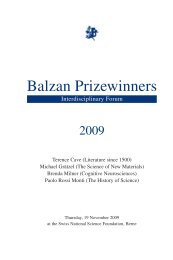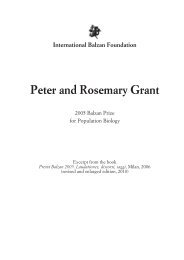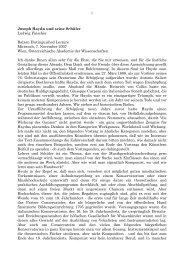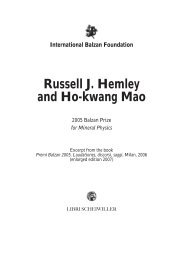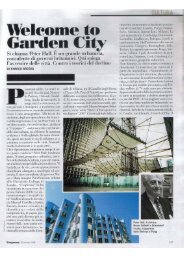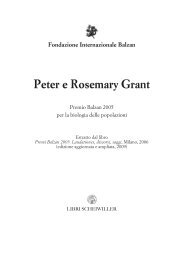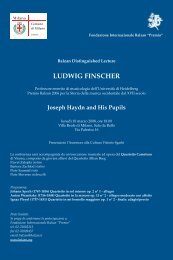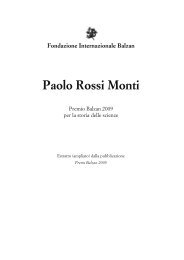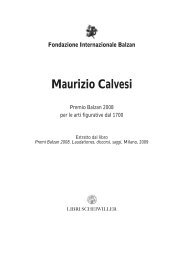International Balzan Foundation Luigi Luca Cavalli
International Balzan Foundation Luigi Luca Cavalli
International Balzan Foundation Luigi Luca Cavalli
Create successful ePaper yourself
Turn your PDF publications into a flip-book with our unique Google optimized e-Paper software.
<strong>Luigi</strong> <strong>Luca</strong> <strong>Cavalli</strong>-Sforza<br />
The Developments of My Research after the <strong>Balzan</strong> Prize (1999-2009)<br />
by <strong>Luigi</strong> <strong>Luca</strong> <strong>Cavalli</strong>-Sforza<br />
Professor Emeritus at the School of Medicine, Stanford University<br />
The <strong>Balzan</strong> <strong>Foundation</strong> has taken the kind initiative of republishing in English<br />
and Italian writings I had prepared for the <strong>Foundation</strong> on the occasion of receiving<br />
the <strong>Balzan</strong> Prize (1999). My scientific activity has since continued and I<br />
thought it useful to prepare a short update.<br />
In 1999 I was, (and had been since 1992, according to the rules then in force), a<br />
professor emeritus in the Department of Genetics at Stanford University Medical<br />
School, though I officially remained “active”, meaning that I kept the right<br />
to maintain my laboratory so long as I had the necessary research funds. In the<br />
USA the best known universities expect professors to finance their own research<br />
with funds from external foundations, which are much more numerous<br />
and active than in Italy.<br />
In 1992 I began to spend half of my year in Italy to continue research I had never<br />
fully abandoned, and also started some new projects. In the first of these I<br />
began a collaboration with my son Francesco to write science textbooks for<br />
Italian secondary schools, which continues. Three scientific projects were effectively<br />
started after the year 2000, even though they had been conceived of<br />
and partly begun long before. One of these, called the Human Genome Diversity<br />
Panel (HGDP) is a collection of lymphocyte cell lines from more than a total<br />
of 1000 individuals, belonging to 52 ethnic groups from the five continents,<br />
for obtaining DNA to distribute to non- commercial research laboratories – to<br />
avoid DNA patenting which would have ruined research. These laboratories<br />
made an undertaking to make their results public in detail before publications<br />
using them, in order to favor further research by laboratories of human population<br />
genetics, which are now numerous, from all over the world. This research<br />
needs a large number of data. The cell lines were collected with the help<br />
of several researchers, mostly personal friends, and are housed in the Paris<br />
CEPH (Centre d’Etudes des Polymorphismes Humains) founded by Jean<br />
Dausset, under the direction of Professor Howard Cann. The distribution of<br />
DNAs to laboratories interested in analyzing them was begun in 2002, and to-<br />
25



